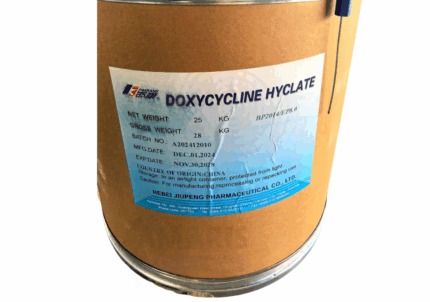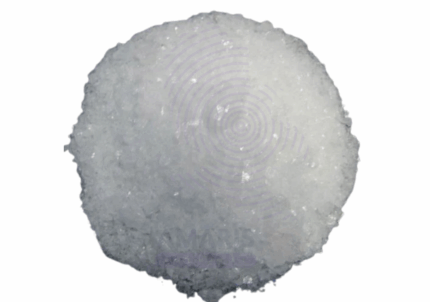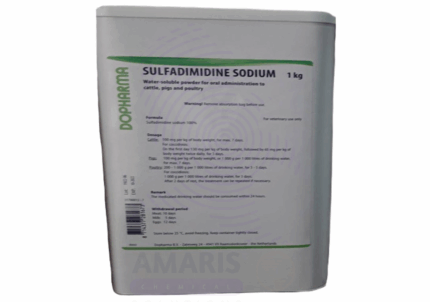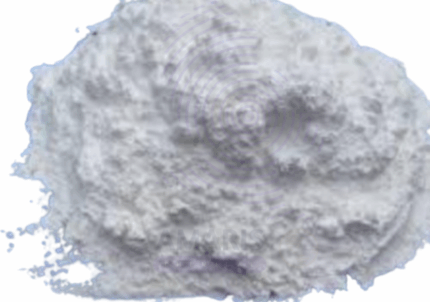

Tylosin Tartrate
Tylosin Tartrate is a water-soluble macrolide antibiotic derived from Streptomyces fradiae, primarily used in veterinary medicine. It is the tartrate salt form of tylosin, enhancing its solubility and making it ideal for administration via drinking water or injectable solutions. Tylosin Tartrate is active against a wide range of Gram-positive bacteria and some Gram-negative organisms, as well as Mycoplasma spp. It is particularly effective for treating respiratory, gastrointestinal, and reproductive infections in livestock and poultry.
Primary Uses
Veterinary Medicine
Poultry:
Treatment and prevention of chronic respiratory disease (CRD) caused by Mycoplasma gallisepticum.
Controls infectious sinusitis in turkeys and synovitis caused by Mycoplasma synoviae.
Administered via drinking water or feed.
Swine:
Used for ileitis, swine dysentery, and enzootic pneumonia (caused by Mycoplasma hyopneumoniae and Brachyspira hyodysenteriae).
Often included in medicated feed or water.
Cattle:
Controls bovine respiratory disease complex (shipping fever) caused by Pasteurella, Mycoplasma, and Haemophilus species.
Also used for foot rot and metritis.
Sheep and Goats:
Treats respiratory infections and mycoplasma-related arthritis.
Companion Animals (off-label in some countries):
Sometimes used to treat chronic colitis or diarrhea in dogs and cats under veterinary supervision.
Aquaculture (where permitted)
Used against Mycoplasma-like organisms and secondary bacterial infections.
Secondary Uses
Prophylactic Use in Herds/Fluctuations
Administered during high-stress periods (transport, weaning, vaccination) to prevent outbreaks.
Growth Promotion (where legal)
Historically used in low doses as a feed additive to promote growth and improve feed efficiency, though now restricted in many countries.
Research & Microbiology
Used as a selective antibiotic in culture media for isolating Mycoplasma species.
Applied in antimicrobial resistance studies.
Chemical Name (IUPAC): Tylosin hydrogen tartrate
Common/Trade Name: Tylosin Tartrate
CAS Number: 1405-69-0
HS Code: 2941.90.00
Synonyms: Tylosin hydrogen tartrate, Macrolide antibiotic tartrate salt
Physical & Chemical Properties
Physical State: Powder
Color & Odor: Pale yellow to yellow; mild characteristic odor
Solubility: Freely soluble in water
Molecular Formula: C46H77NO17 · C4H6O6
Molecular Weight: ~1009.2 g/mol
pH (1% solution): 5.0–7.5
Loss on Drying: ≤ 5.0%
Assay (Potency): ≥ 800 µg/mg (potency based on tylosin activity)
Safety & Hazard Attributes
GHS Classification:
May cause respiratory or skin sensitization
Harmful if swallowed or inhaled in large quantities
Environmental hazard (to aquatic life with long-term effects)
Toxicity: Low toxicity to treated animals when used as directed
Irritation: May cause skin and eye irritation in handlers
Occupational Hazards: Allergic reactions (especially in individuals sensitive to macrolides)
Storage & Handling Attributes
Storage Conditions: Store below 25 °C in a dry place; protect from light and moisture
Container Type: Fiber drums or HDPE containers with inner liner
Shelf Life: 24–36 months under proper storage
Handling Precautions: Avoid inhalation of dust; wear protective gloves, eyewear, and mask
Regulatory & Compliance Attributes
Approved for veterinary use by FDA, EMA, WHO, and OIE (in various countries)
Not intended for human use
Must comply with maximum residue limits (MRLs) in food-producing animals
Complies with Good Manufacturing Practices (GMP) for veterinary pharmaceuticals
Use in accordance with Veterinary Prescription Regulations (region-specific)
Environmental & Health Impact
Biodegradability: Biodegradable under normal environmental conditions
Ecotoxicity: Potential impact on soil and aquatic microbiota if improperly disposed
Bioaccumulation: Low potential
Resistance Risk: May contribute to antimicrobial resistance if overused or misused
PPE Required: Gloves, dust mask, safety goggles
Handling Guidelines: Avoid generation of dust; use in well-ventilated areas
Storage Measures: Keep container tightly closed and dry
First Aid Measures
Inhalation: Move to fresh air; seek medical attention if symptoms persist
Skin Contact: Wash with soap and water
Eye Contact: Rinse with plenty of water; get medical help if irritation continues
Ingestion: Rinse mouth; consult a veterinarian or poison control if large quantities are consumed
Firefighting Measures
Fire Hazards: Not highly flammable but combustible in powder form
Extinguishing Media: Use water spray, foam, dry chemical, or CO₂
Hazardous Combustion Products: Carbon monoxide, carbon dioxide, nitrogen oxides


 Preservatives(food)
Preservatives(food) Flavor Enhancers
Flavor Enhancers Acidulants
Acidulants Sweeteners
Sweeteners Antioxidants
Antioxidants Colorants(food)
Colorants(food) Nutraceutical Ingredients (food)
Nutraceutical Ingredients (food) Nutrient Supplements
Nutrient Supplements Emulsifiers
Emulsifiers
 Collectors
Collectors Dust Suppressants
Dust Suppressants Explosives and Blasting Agents
Explosives and Blasting Agents Flocculants and Coagulants
Flocculants and Coagulants Frothers
Frothers Leaching Agents
Leaching Agents pH Modifiers
pH Modifiers Precious Metal Extraction Agents
Precious Metal Extraction Agents
 Antioxidants(plastic)
Antioxidants(plastic) Colorants (Pigments, Dyes)
Colorants (Pigments, Dyes) Fillers and Reinforcements
Fillers and Reinforcements Flame Retardants
Flame Retardants Monomers
Monomers Plasticizers
Plasticizers Polymerization Initiators
Polymerization Initiators Stabilizers (UV, Heat)
Stabilizers (UV, Heat)
 Antifoaming Agents
Antifoaming Agents Chelating Agents
Chelating Agents Coagulants and Flocculants
Coagulants and Flocculants Corrosion Inhibitors
Corrosion Inhibitors Disinfectants and Biocides
Disinfectants and Biocides Oxidizing Agents
Oxidizing Agents pH Adjusters
pH Adjusters Scale Inhibitors( water)
Scale Inhibitors( water)
 Antioxidants(cosmetic)
Antioxidants(cosmetic) Emollients
Emollients Fragrances and Essential Oils
Fragrances and Essential Oils Humectants
Humectants Preservatives
Preservatives Surfactants(cosmetic)
Surfactants(cosmetic) Thickeners
Thickeners UV Filters
UV Filters
 Fertilizers
Fertilizers Soil Conditioners
Soil Conditioners Plant Growth Regulators
Plant Growth Regulators Animal Feed Additives
Animal Feed Additives Biostimulants
Biostimulants Pesticides (Herbicides, Insecticides, Fungicides)
Pesticides (Herbicides, Insecticides, Fungicides)
 Active Pharmaceutical Ingredients (APIs)
Active Pharmaceutical Ingredients (APIs) Excipients
Excipients Solvents(pharmaceutical)
Solvents(pharmaceutical) Antibiotics
Antibiotics Antiseptics and Disinfectants
Antiseptics and Disinfectants Vaccine Adjuvants
Vaccine Adjuvants Nutraceutical Ingredients (pharmaceutical)
Nutraceutical Ingredients (pharmaceutical) Analgesics & Antipyretics
Analgesics & Antipyretics
 Analytical Reagents
Analytical Reagents Solvents(lab)
Solvents(lab) Chromatography Chemicals
Chromatography Chemicals Spectroscopy Reagents
Spectroscopy Reagents microbiology-and-cell-culture-reagents
microbiology-and-cell-culture-reagents Molecular Biology Reagents
Molecular Biology Reagents Biochemical Reagents
Biochemical Reagents Inorganic and Organic Standards
Inorganic and Organic Standards Laboratory Safety Chemicals
Laboratory Safety Chemicals Specialty Laboratory Chemicals(Special Laboratory Equipment)
Specialty Laboratory Chemicals(Special Laboratory Equipment)
 Demulsifiers
Demulsifiers Hydraulic Fracturing Fluids
Hydraulic Fracturing Fluids Scale Inhibitors(oil)
Scale Inhibitors(oil) Surfactants(oil)
Surfactants(oil) Drilling Fluids
Drilling Fluids
 Dyes and Pigments
Dyes and Pigments Bleaching Agents
Bleaching Agents Softening Agents
Softening Agents Finishing Agents
Finishing Agents Antistatic Agents
Antistatic Agents
 Admixtures
Admixtures Waterproofing Agents
Waterproofing Agents Sealants and Adhesives
Sealants and Adhesives Curing Compounds
Curing Compounds Concrete Repair Chemicals
Concrete Repair Chemicals Anti-Corrosion Coatings
Anti-Corrosion Coatings
 Surfactants(cleaning)
Surfactants(cleaning) Builders
Builders Enzymes
Enzymes Solvents (Cleaning)
Solvents (Cleaning) Fragrances
Fragrances
 Electronic Chemicals
Electronic Chemicals Catalysts
Catalysts Lubricants
Lubricants Photographic Chemicals
Photographic Chemicals Refrigerants
Refrigerants Automotive chemicals
Automotive chemicals Pyrotechnic Chemicals
Pyrotechnic Chemicals
 Biodegradable Surfactants
Biodegradable Surfactants Bio-based Solvents
Bio-based Solvents Renewable Polymers
Renewable Polymers Carbon Capture Chemicals
Carbon Capture Chemicals Wastewater Treatment Chemicals
Wastewater Treatment Chemicals
 Pigments
Pigments Solvents(paint)
Solvents(paint) Specialty Coatings
Specialty Coatings Binders/Resins
Binders/Resins Additives
Additives Driers
Driers Anti-Corrosion Agents
Anti-Corrosion Agents Functional Coatings
Functional Coatings Application-Specific Coatings
Application-Specific Coatings
 Fresh Herbs
Fresh Herbs Ground Spices
Ground Spices Whole Spices
Whole Spices Spice Blends
Spice Blends Dried Herbs
Dried Herbs
 Leavening Agents
Leavening Agents Dough Conditioners
Dough Conditioners Flour Treatments
Flour Treatments Fat Replacers
Fat Replacers Decoratives
Decoratives Preservatives(baking)
Preservatives(baking)
 Plasticizers & Softeners
Plasticizers & Softeners Reinforcing Agents
Reinforcing Agents Adhesion Promoters
Adhesion Promoters Vulcanizing Agents
Vulcanizing Agents Antidegradants
Antidegradants Blowing Agents
Blowing Agents Fillers & Extenders
Fillers & Extenders Accelerators & Retarders
Accelerators & Retarders

























